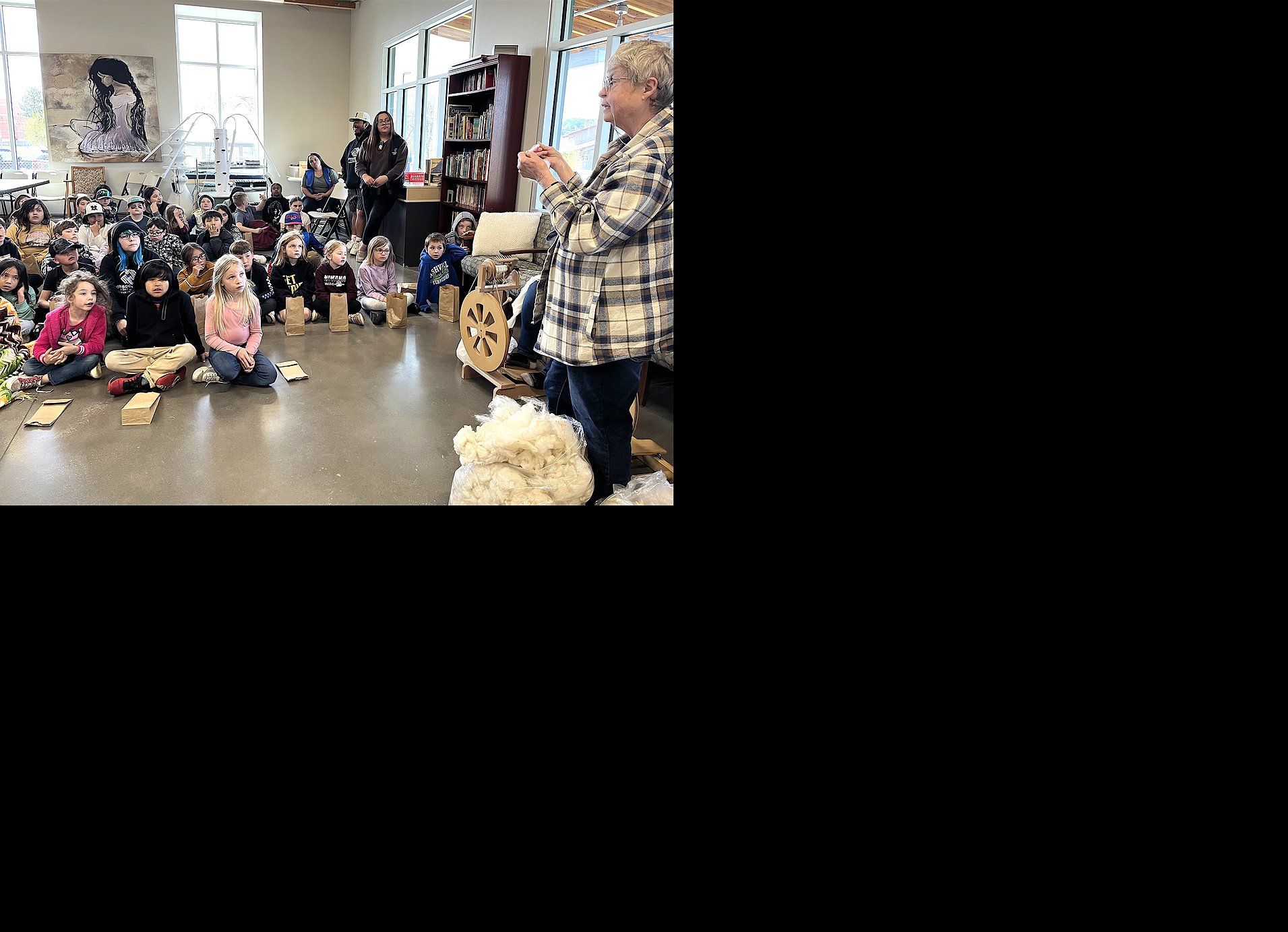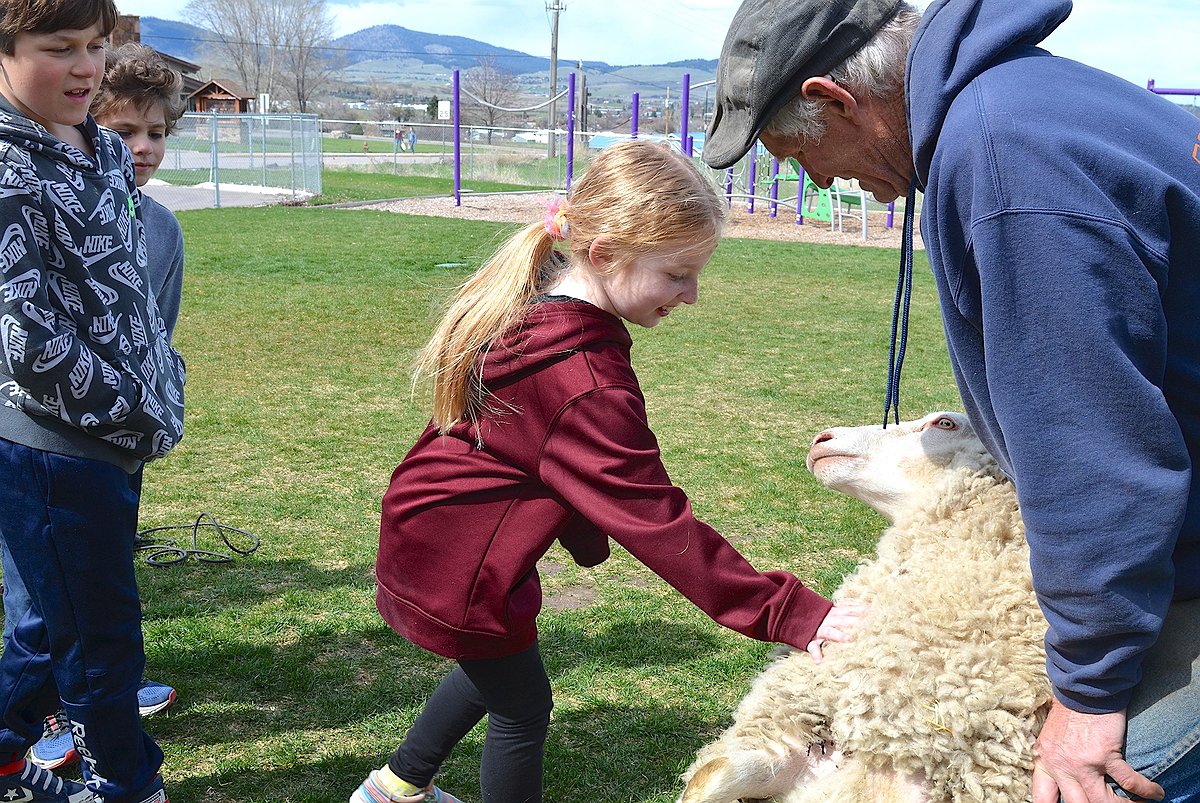Defrocking Miss Daisy: Sheep shearer and spinners share wool basics
KRISTI NIEMEYER | Hagadone News Network | UPDATED 1 year, 8 months AGO
Kristi Niemeyer is editor of the Lake County Leader. She learned her newspaper licks at the Mission Valley News and honed them at the helm of the Ronan Pioneer and, eventually, as co-editor of the Leader until 1993. She later launched and published Lively Times, a statewide arts and entertainment monthly (she still publishes the digital version), and produced and edited State of the Arts for the Montana Arts Council and Heart to Heart for St. Luke Community Healthcare. Reach her at [email protected] or 406-883-4343. | April 25, 2024 12:00 AM
Daisy announced her presence at the Boys and Girls Club in Polson last week by leaving a fragrant deposit on the floor of the entryway, which in turn caused a boy to squeeze his nose closed and scurry past.
Daisy was on her way to the back lawn, where a herd of kids had gathered to watch her lose her wool coat, courtesy of her owner, local sheep shearer Will Tusick. Daisy, who was born in November, is part Coopworth – a New Zealand breed known for their long wool and gentle disposition – and East Friesian, a milk-producing breed.
As he prepared to do the deed, Tusick introduced himself as someone who has shorn sheep for 40 years, mostly in western Montana, but also in Wyoming, Utah, Idaho, Nevada, Hawaii and even Ireland. He also extolled the many virtues of sheep and their coats.
“Sheep,” he told his somewhat rapt audience, “are a universal animal. They're everywhere in the world.”
They supply meat, milk, and the wool that Daisy was about to yield, which “is just a great insulator,” Tusick said. “It keeps you warm when it's wet. It doesn't burn (which is why firefighters used to wear it) … and it’s extremely tough and durable.”
Wool also accepts color, imparted in the dying process, and doesn’t fade. As an added bonus, wool-bearing critters produce lanolin – an oily substance that’s used as a base for creams and ointments.
Despite this litany of virtues, few ranchers raise sheep in the Mission Valley anymore.
Tusick gestured north toward Jette Hill. “A long time ago, they used to run a thousand head of sheep up on that hill every winter,” he told his young audience. And 25 years ago, around 100,000 pounds of wool were shipped from the Mission Valley every spring.
“Now, we haven't shipped wool for two years because there's just no sheep the valley,” he said.
Before he began shearing, he rolled Daisy over so she was reclining on her back haunches, leaning against his knees.
“They're a lot more comfortable being tipped over and shorn on an empty stomach,” he told youngsters. “But her tummy's full – it's my fault because I forgot to take her off her feed this morning.”
Kids were invited to pet Daisy and quickly mobbed the overturned sheep before the staff convinced them to line up and take turns.
After explaining the tools of his trade – a set of hand shears and an electric handpiece, equipped with a comb and a cutting blade – Tusick began to smoothly peel off Daisy’s coat, rotating her from side to side.
Questions and observations abounded:
“Is he softer when you shave him?”
“It feels like I'm going to be stuck in a spider web.”
“How does she stay warm?”
“Why are her knees dirty?”
“Are you going to kill that sheep?”
The answer to the latter question was no, since she’s a female and would be tasked with producing lambs.
“This breed of sheep will live, oh, maybe 12 years,” Tusick said. “So in her lifetime, she might have over 20 lambs.”
If Daisy were a male, however, his fate would be different.
“How do you combine wool together to make a coat?”
That question was answered indoors where a trio of spinners – Linda Kittle, Mary Hertz and Mary Sale – demonstrated how to transform raw wool into yarn.
Kittle pulled some of Daisy’s wool from the fleece that Tusick had tossed onto a table and pulled the wavy fibers apart to show the fiber’s crimp, “like a crinkle-cut French fry.”
She demonstrated how people first made yarn by simply taking a lock of wool, stretching it out and twisting it together by rolling it along her leg.
“There are people in Papua New Guinea and other places that still spin wool that way,” she said.
Next, “some smart person invented what’s called a drop spindle” to lengthen and twist the fibers together.
Kittle demonstrated how raw wool is washed, combed and then carded before a spinner begins twisting the fiber into yarn on a spinning wheel. Artisans then use natural ingredients, such as lichen, onion skin or walnuts, to dye the yarn.
“Or, if you're a modern kind of person, you can get out the Kool-Aid,” she said, displaying some neon-bright skeins. She also demonstrated some basic weaving techniques used to transform yarn into fabric.
Each kid was invited to take home some of Daisy’s wool, while the dazed Daisy was driven home, minus her wool coat.
ARTICLES BY KRISTI NIEMEYER

County, Tribes still wrangling with state for PL 280 money
Funding for Public Law 280 – the federal legislation that governs how felonies involving tribal members are prosecuted on the Flathead Reservation – continues to evade Lake County and the Confederated Salish and Kootenai Tribes, which have yet to secure a promised payment of $1.25 million apiece from the State of Montana.

Polson Commission weighs pros, cons of second fire station
The debate over the potential location of a second fire station for the City of Polson elicited questions and suggestions at a public workshop Monday night, held prior to the regular city commission meeting.

Rotarians disperse free dictionaries to third graders in Lake County
To all those cynical adults who think dictionaries have gone the way of dinosaurs, replaced by omnipresent search engines: third graders across Lake County beg to differ.







